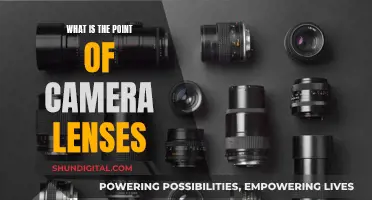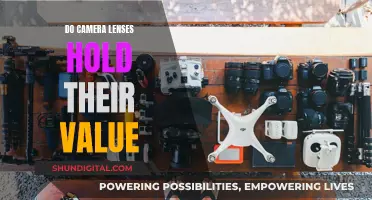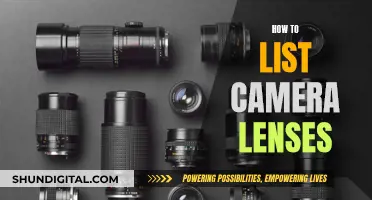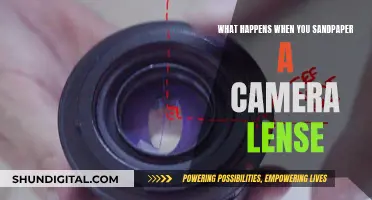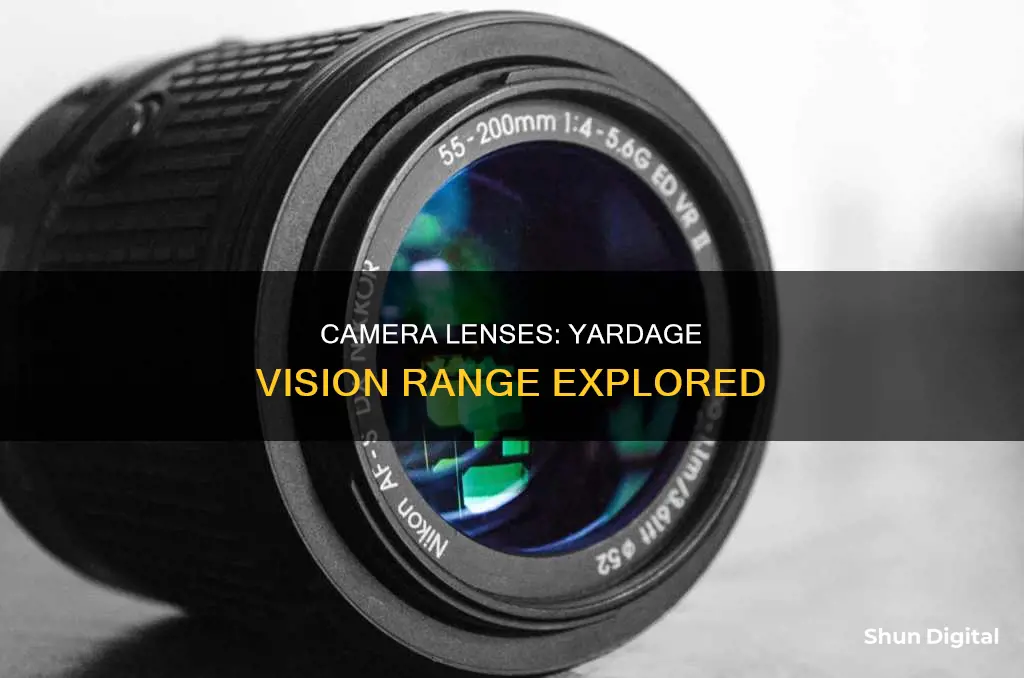
The distance a camera lens can see depends on several factors, including the focal length of the lens, the size of the image sensor, and the desired field of view. A lens with a longer focal length will bring the subject closer, while a wider lens will capture a broader field of view. The size of the image sensor also affects the effective focal length, with larger sensors requiring longer lenses to achieve the same field of view as smaller sensors. Additionally, the distance from the camera also plays a role in determining the final image quality, as the object being photographed needs to be within the camera's focal range.
| Characteristics | Values |
|---|---|
| Focal length | 50mm, 100mm, 200mm, 300mm, 400mm, 600mm, 800mm, 1200mm, 1800mm |
| Field of view | Narrow, ultra-wide |
| Angle of view | Depends on the sensor size |
| Zoom | 2.85x, 7x, 10x |
| Sensor size | APS-C, full-frame 35mm |
| Distance from subject | 10 feet, 20 feet, 50 feet, 100 feet, 150 feet, 200 feet |
What You'll Learn

Camera lens focal length
The longer the focal length, the narrower the angle of view, and the higher the magnification. This means that objects appear larger in the frame and more detail can be captured. Lenses with longer focal lengths are often used in wildlife and sports photography, where the subjects are distant and the photographer wants to fill the frame with the subject.
On the other hand, shorter focal lengths result in a wider angle of view and lower magnification. This is ideal for capturing sweeping landscapes, architectural photography, or when working in confined spaces.
It is also worth noting that the camera sensor size can affect the field of view. Smaller sensors, often found in crop-sensor cameras, will result in a narrower field of view compared to a full-frame sensor. This is known as the crop factor or focal length multiplier. For example, a 50mm lens on a Canon APS-C camera (with a crop factor of 1.6x) will have an effective focal length of 80mm.
Lenses can be categorised into two types: prime and zoom. Prime lenses have a fixed focal length, such as 35mm, 50mm, or 85mm. Zoom lenses, on the other hand, have variable focal lengths, such as 24-105mm or 100-400mm. Zoom lenses offer more versatility but prime lenses tend to be more compact, lightweight, and have larger apertures, making them ideal for low-light conditions and achieving a shallow depth of field.
When choosing a lens, it is important to consider the desired field of view and magnification. A longer focal length will bring objects closer, while a shorter focal length will capture a wider vista. Additionally, the sensor size of the camera will also impact the final image.
The Art of Camera Lenses: Beautify or Uglify?
You may want to see also

Camera sensor size
The distance a camera lens can see is dependent on a few factors, including the pixels per foot (PPF), the focal length of the camera lens, and the resolution of the camera. The PPF is a measurement of the quality of the final video produced based on the size of the area the video is recording. The higher the PPF, the better the quality of the image. The focal length of the camera lens will also determine how far the camera can see, with longer focal lengths being more important than the absolute widest aperture when it comes to shooting outdoors.
The crop factor is the sensor's diagonal size compared to a full-frame 35 mm sensor. A cropped sensor discards the outer part of the image, which can be useful when using low-quality lenses as it removes the lowest-quality portions of the image. However, this also means carrying a larger lens than necessary. Smaller sensors require lighter lenses for the same angle of view, zoom range, build quality, and aperture range.
The focal length multiplier relates the focal length of a lens used on a smaller format to a 35 mm lens, producing an equivalent angle of view. For example, a 50 mm lens used on a sensor with a 1.6X crop factor would give the same field of view as an 80 mm lens on a 35 mm full-frame sensor.
The choice between a larger or smaller sensor depends on one's needs. Larger sensors provide more control and artistic flexibility but require larger lenses and more expensive equipment. Smaller sensors are more practical for most photographers and are commonly used in camera phones and compact cameras.
Olympus Lenses: Universal Fit for All Olympus Cameras?
You may want to see also

Camera lens autofocus speed
The autofocus speed of a camera lens is influenced by a combination of factors, including the camera body, lens hardware, firmware, and light levels.
Camera Body
The camera body plays a significant role in autofocus speed. The autofocus drive system and sensor in the camera body contribute to the overall performance. The number and type of autofocus sensors vary across camera models, impacting accuracy and speed. Modern cameras with more advanced autofocus sensors and higher processing power can achieve faster and more accurate autofocus.
Lens Hardware and Firmware
The lens hardware and firmware are crucial in autofocus speed. Lenses with ultrasonic motors, designated as USM (Canon), SWM (Nikon and Olympus), SSW (Sony), or HSM (Sigma), generally offer faster autofocus. The lens firmware also affects performance, with newer lenses often providing faster and more accurate autofocus capabilities.
Additionally, the length of the zoom range impacts autofocus speed. Lenses with longer zoom ranges tend to have slower autofocus lock-on times. This is why professionals often prefer prime lenses (lenses with a fixed focal length) for sports photography.
Light Levels
Light levels are critical to autofocus speed and accuracy. Lower light conditions can result in slower autofocus performance and reduced accuracy. Modern cameras with improved autofocus algorithms can mitigate this issue to some extent, but it is still a significant factor to consider.
Other Factors
Other variables, such as ambient temperature, subject contrast, and battery charge, can also influence autofocus speed.
In conclusion, the autofocus speed of a camera lens depends on the interplay between the camera body, lens hardware and firmware, and environmental factors like lighting conditions. When selecting a lens for fast-action photography, it is essential to consider these factors to ensure optimal performance.
Lens Compatibility: Understanding Camera Lens Interchangeability
You may want to see also

Camera shooting speed
Shutter speed is measured in seconds or fractions of a second, and it can be adjusted in the camera's settings or by turning a dial on the camera body. The fastest shutter speed on most cameras is 1/8000 of a second, while the slowest is typically 30 seconds.
A fast shutter speed freezes motion, even from fast-moving objects. It is often used to capture sharp images of birds in flight or athletes in sports. Slower shutter speeds, on the other hand, create motion blur, which can be used to communicate a sense of speed or motion in advertisements or to create artistic effects in landscape photography.
When choosing a shutter speed, it's important to consider whether you need to freeze the subject or create motion blur. For freezing motion, a fast shutter speed such as 1/500, 1/1000, or even faster is recommended. For creating motion blur, a slower shutter speed such as 1/20 or longer is more suitable.
In addition to the creative aspects, shutter speed also affects the exposure of the image. A longer shutter speed allows more light to reach the camera sensor, resulting in a brighter image. Conversely, a faster shutter speed reduces the amount of light, leading to a darker image. Therefore, when using a fast shutter speed, it's important to compensate with a higher ISO or wider aperture to ensure enough light reaches the sensor.
Understanding shutter speed is crucial for photographers to capture great images. It allows them to control the brightness and motion blur in their photographs, enabling them to create sharp, frozen moments or artistic, blurred effects.
Lens Identification: Serial Numbers on Camera Lenses
You may want to see also

Camera aperture
Aperture is one of the three pillars of photography, alongside shutter speed and ISO. It refers to the opening in a lens through which light passes to enter the camera. The aperture can be adjusted to control the amount of light that enters the camera, similar to how the iris in our eyes expands or shrinks to control the size of our pupil.
Aperture is calibrated in f-stops, written as f/numbers, such as f/1.4, f/2, f/2.8, etc. Lower f-stops represent larger apertures, resulting in more exposure and a blurrier background. Higher f-stops represent smaller apertures, leading to less exposure and a sharper background. It is important to note that small f-stop numbers represent large apertures, which can be counterintuitive for beginners.
The choice of aperture depends on the desired depth of field, which is the zone of acceptable sharpness in front of and behind the subject. A large aperture (low f-stop) creates a shallow depth of field, often used in portrait photography to separate the subject from the background. On the other hand, a small aperture (high f-stop) results in a wider depth of field, making both the foreground and background sharp, which is ideal for landscape photography.
Aperture also affects shutter speed. A low f-stop means more light enters the lens, allowing for a faster shutter speed. Conversely, a high f-stop means less light enters the lens, requiring a slower shutter speed to achieve the correct exposure.
When choosing a lens, it is important to consider the maximum aperture, as it determines how much light the lens can gather. Lenses with larger maximum apertures, such as f/1.4 or f/1.8, are considered "fast" lenses and are often more expensive.
In summary, aperture plays a crucial role in photography by controlling the amount of light, depth of field, and shutter speed. It is an essential setting for photographers to master, allowing them to achieve the desired artistic look and capture spectacular images.
Lenses: The True Power Behind Photography
You may want to see also
Frequently asked questions
A 50mm lens is considered a "normal" lens, meaning it offers a perspective similar to how our eyes see. The distance of how far a 50mm lens can see depends on the size of the subject in the frame.
A 100mm lens is considered a short telephoto or portrait lens, offering a more flattering perspective for portraits. The distance of how far a 100mm lens can see depends on the size of the subject in the frame.
A 200mm lens is considered a telephoto lens, often used for sports and wildlife photography. A 200mm lens can bring a subject 4 times closer. The distance of how far a 200mm lens can see depends on the size of the subject in the frame.
A 400mm lens is a telephoto lens, often used for bird photography. A 400mm lens can bring a subject 8 times closer. The distance of how far a 400mm lens can see depends on the size of the subject in the frame.



